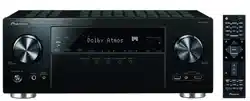Documents: Go to download!
- User Manual - (English)
- Contents
- Connections
- Troubleshooting
Table of contents
Owner's Guide Audio
Contents
What’s in the box

- Main unit (1)
- Remote controller (RC-957R) (1),
Batteries (AAA/R03) (2) - Speaker setup microphone (1)
Used during Initial Setup. - Indoor FM antenna (1)
- AM loop antenna (1)
- Power cord (1)
Quick Start Guide (1)
*This document is an online instruction manual. It is not included as an accessory.
- Connect speakers with an impedance of 4 Ω to 16 Ω.
- The power cord must be connected only after all other connections are completed.
- We will not accept any responsibility for damage arising from the connection with equipment manufactured by other companies.
- Network services and content that can be used may no longer be available if new functions are added by updating firmware or the service providers terminate their services. Also, available services may differ depending on your area.
- Details on the firmware update will be posted on our website and through other means at a later date.
- Specifications and appearance are subject to change without prior notice.
Part Names
Front Panel
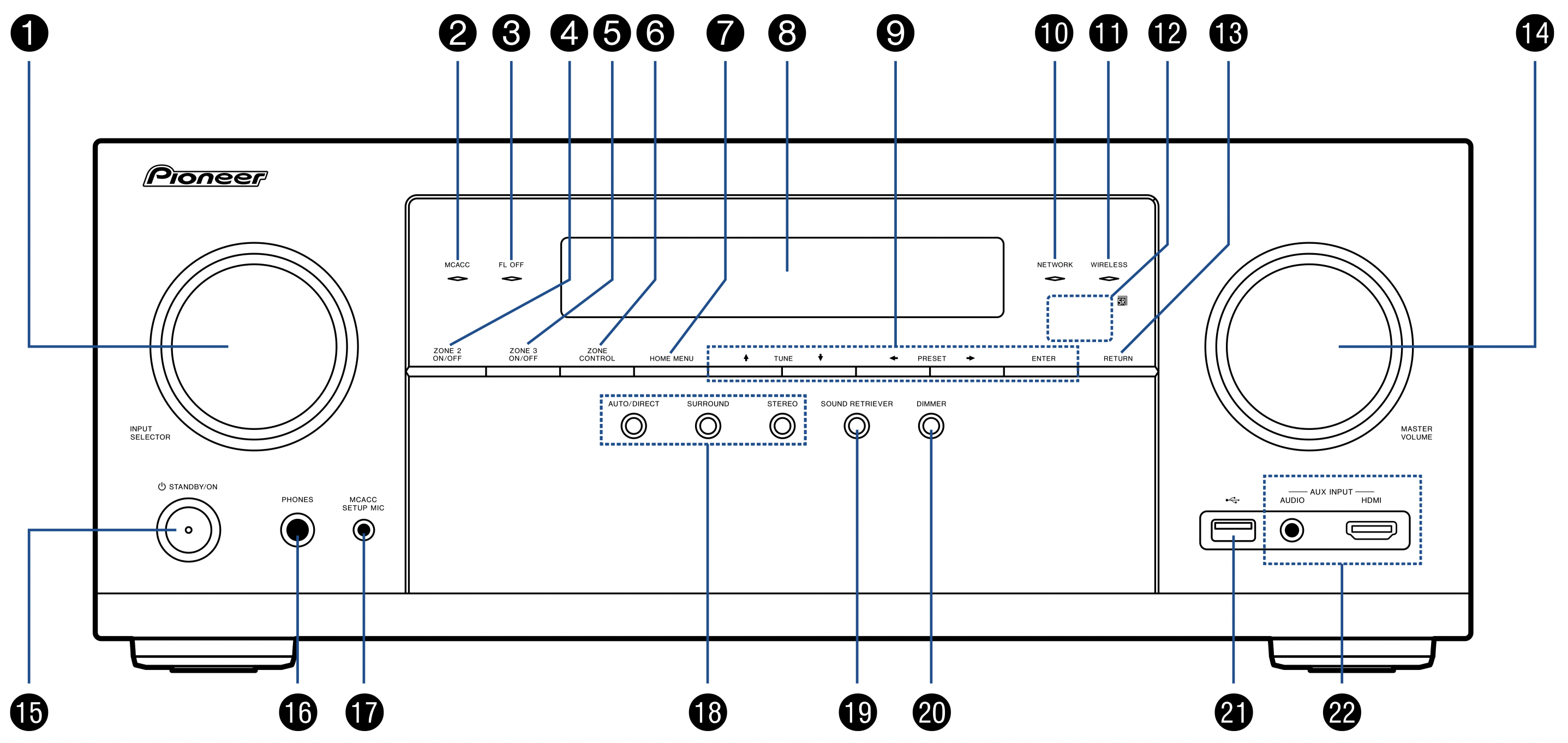
- INPUT SELECTOR dial: Switch the input to be played.
- MCACC indicator: This lights when you have enabled the speaker calibration made with MCACC. (p122, p139)
- FL OFF indicator: This lights when you have pressed DIMMER repeatedly to turn the display off.
- ZONE 2 ON/OFF button: Turns ZONE 2 ON/OFF. (p85)
- ZONE 3 ON/OFF button: Turns ZONE 3 ON/OFF.(p85)
- ZONE CONTROL button: Controls the multi-zone function. (p85)
- HOME MENU button: Displays the Home. (p100, 121, 126)
- Display (p8)
- Cursor buttons (
 /
/  /
/  /
/  ) and ENTER button: Select the item with the cursors and press ENTER to confirm. Use them to tune to stations when using TUNER. (p78)
) and ENTER button: Select the item with the cursors and press ENTER to confirm. Use them to tune to stations when using TUNER. (p78) - NETWORK indicator: This lights when "NET" is selected with the input selector and the unit is connected to the network. If the unit is in standby mode, this lights when functions such as HDMI CEC and network standby are enabled. It does not light when ZONE 2/ZONE 3 is on, however.
- WIRELESS indicator: Lights when the unit is connected to the wireless network and when connected to a BLUETOOTH enabled device.
- Remote control sensor: Receives signals from the remote controller.
The signal range of the remote controller is within about 16´/5 m, at an angle of 20° on the perpendicular axis and 30° to either side. - RETURN button: Returns the display to the previous state.
- MASTER VOLUME
 STANDBY/ON button
STANDBY/ON button- PHONES jack: Headphones with a standard plug (ø1/4"/6.3 mm) are connected.
- MCACC SETUP MIC jack: The supplied speaker setup microphone is connected.(p122, p139)
- Listening mode button: Press "AUTO/DIRECT", "SURROUND" or "STEREO" to switch the listening mode. (p86)
- SOUND RETRIEVER button: Turns on/off the Sound Retriever function that provides better sound quality for compressed audio.
- DIMMER button: You can switch the display off or adjust the brightness of the display in three steps.
- USB port: A USB storage device is connected so that music files stored in it can be played. (p68) You can also supply power (5 V/500 mA) to USB devices with a USB cable.
- AUX INPUT AUDIO/HDMI jack: Connect a video camera, etc. using a stereo mini plug cable (ø1/8″/3.5 mm) or HDMI cable. (p52)
Display

- This may light when performing operations with the "NET", "USB" input selector.
- Lights in the following conditions.
Z2/Z3: ZONE 2/ZONE 3 is on. : Connected by BLUETOOTH.
: Connected by BLUETOOTH. : Connected by Wi-Fi.
: Connected by Wi-Fi.
NET: Lights when connected to the network with the "NET" input selector. It will blink if incorrectly connected to the network.
USB: Lights when the "NET" input selector is selected, a USB device is connected and the USB input is selected. It will blink if the USB device is not properly connected.
HDMI: HDMI signals are input and the HDMI input is selected.
DIGITAL: Digital signals are input and the digital input is selected. - Lights according to the type of input digital audio signal and the listening mode.
- Lights in the following conditions.
RDS (European, Australian and Asian models): Receiving RDS broadcasting.
TUNED: Receiving AM/FM radio.
STEREO: Receiving FM stereo.
SLEEP: Sleep timer is set. (p114)
AUTO STBY: Auto Standby is set. (p114) - Lights when headphones are connected.
- Blinks when muting is on.
- Displays various information of the input signals.
- Lights when adjusting the volume.
- Speaker/Channel display: Displays the output channel that corresponds to the selected listening mode.
Rear Panel
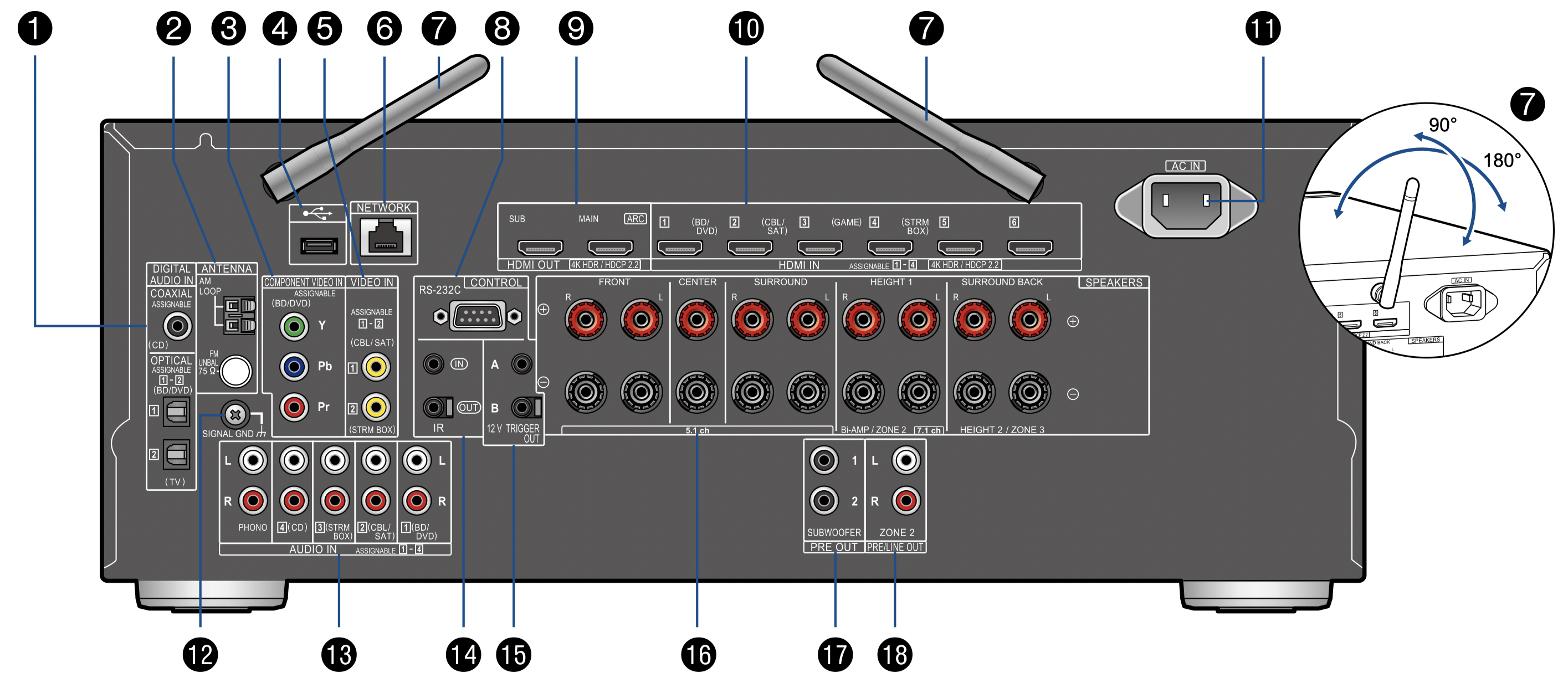
- DIGITAL AUDIO IN OPTICAL/COAXIAL jacks: Input TV or AV component digital audio signals with a digital optical cable or digital coaxial cable.
- ANTENNA AM LOOP/FM UNBAL 75Ω terminal: The supplied antennas are connected.
- COMPONENT VIDEO IN jacks: Input the AV component video signals with a component video cable. (Compatible only with 480i or 576i resolution.)
- USB port: A USB storage device is connected so that music files stored in it can be played. (p68) You can also supply power (5 V/500 mA) to USB devices with a USB cable.
- VIDEO IN jacks: Input the AV component video signals with an analog video cable.
- NETWORK port: Connect to the network with a LAN cable.
- Wireless antenna: Used for Wi-Fi connection or when using a BLUETOOTH enabled device. Adjust their angles according to the connection status.
- RS-232C port: Connect a home control system equipped with an RS-232C port. For adopting a home control system, contact the specialized stores.
- HDMI OUT jacks: Transmit video signals and audio signals with an HDMI cable connected to a monitor such as a TV or projector.
- HDMI IN jacks: Transmit video signals and audio signals with a HDMI cable connected to an AV component.
- AC IN: The supplied power cord is connected.
- SIGNAL GND terminal: The ground wire of the turntable is connected.
- AUDIO IN jacks: Input AV component audio signal with an analog audio cable.
- IR IN/OUT port: Connect a remote control receiver unit.( p56)
- 12V TRIGGER OUT A/B jack: Connect a device equipped with a 12V trigger input jack to enable power link operation between the device and this unit. ( p57)
- SPEAKERS terminals: Connect speakers with speaker cables. (North American models support banana plugs.)
- SUBWOOFER PRE OUT jack: Connect a powered subwoofer with a subwoofer cable. Up to two powered subwoofers can be connected. The same signal is output from each of the SUBWOOFER PRE OUT jacks.
- ZONE 2 PRE/LINE OUT jacks: Output audio signals with an analog audio cable to a premain amplifier or a power amplifier in a separate room (ZONE 2).
Remote Controller
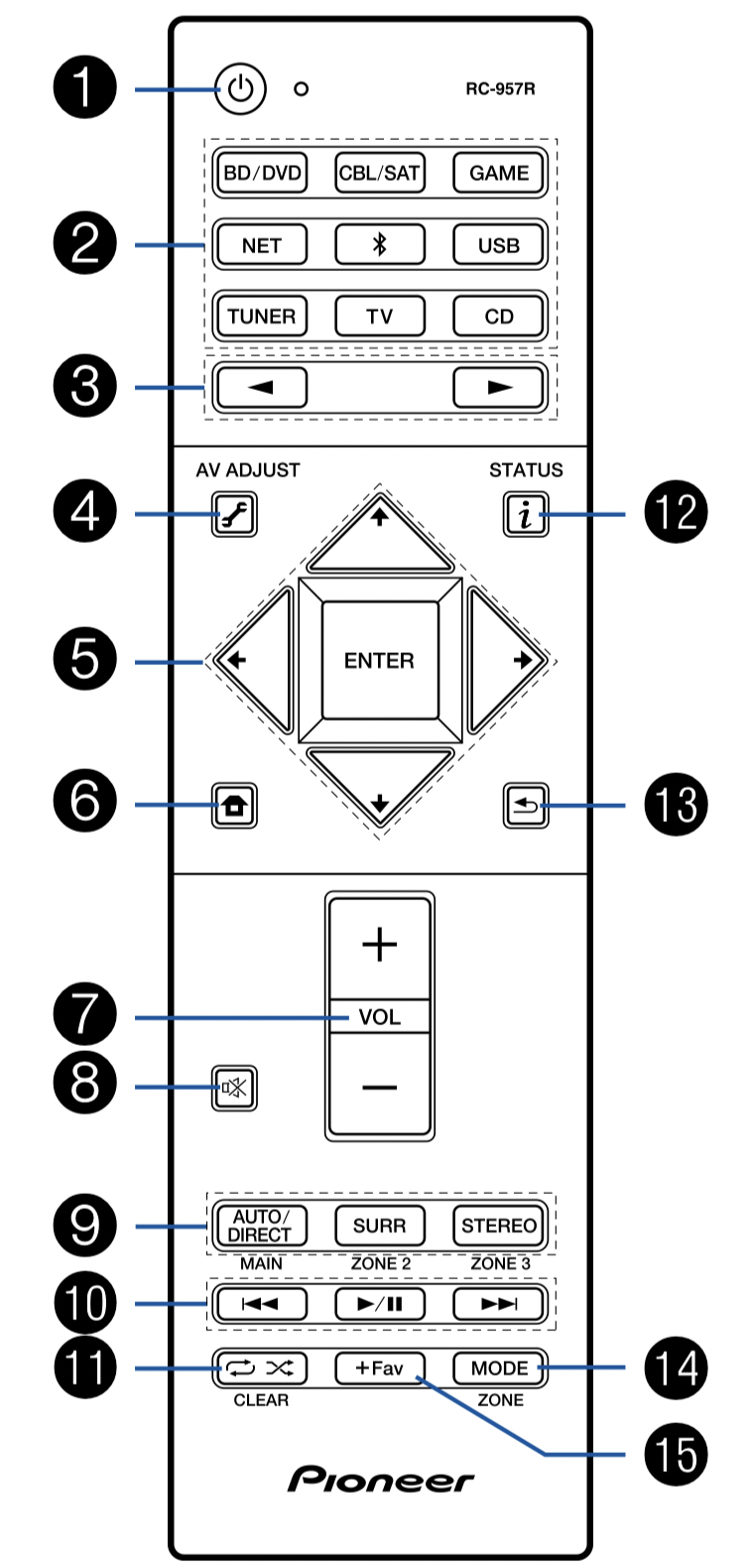
 STANDBY/ON button
STANDBY/ON button- Input selector buttons: Switches the input to be played.
 /
/  buttons: Select the input to be played.
buttons: Select the input to be played. (AV ADJUST) button: Settings such as "Tone" and "Level" can be made quickly during play on the TV screen. ( p130)
(AV ADJUST) button: Settings such as "Tone" and "Level" can be made quickly during play on the TV screen. ( p130)- Cursor buttons and ENTER button: Select the item with the cursors and press ENTER to confirm your selection. When the folder or file lists are not shown on one screen on the TV, press
 /
/  to change the screen.
to change the screen.  button: Displays the Home. ( p100, 121, 126)
button: Displays the Home. ( p100, 121, 126)- Volume buttons
 button: Temporarily mutes audio. Press again to cancel muting.
button: Temporarily mutes audio. Press again to cancel muting.- LISTENING MODE buttons: Allows you to select the listening mode. ( p86) MAIN/ZONE 2/ZONE 3 buttons: Controls the multi-zone function. ( p83)
- Play buttons: Used for play operations when playing Music Server ( p71) or USB ( p68).
 button: Used for repeat or random play operations when playing Music Server ( p71) or USB ( p68). Each time you press the button, the mode switches from
button: Used for repeat or random play operations when playing Music Server ( p71) or USB ( p68). Each time you press the button, the mode switches from  (1-track repeat), to
(1-track repeat), to  (folder repeat), to
(folder repeat), to  (random).
(random).
CLEAR button: Deletes all characters you have entered when entering text on the TV screen. button: Switches the information on the display and is used to operate RDS ( p82).
button: Switches the information on the display and is used to operate RDS ( p82). button: Returns the display to the previous state.
button: Returns the display to the previous state.- MODE button: Used to switch between automatic tuning and manual tuning for AM/FM stations ( p78), or operate the multi-zone function ( p83).
- +Fav button: Used to register AM/FM radio stations. ( p80)
Tips: When the remote controller isn't working: The remote controller may have switched to the ZONE control mode. While pressing and holding MODE, press the MAIN button for 3 seconds or more until the remote indicator blinks once, and then switch it to the main room control mode.

Connections
Connecting the TV
Connect this unit between a TV and AV component. Connecting this unit with the TV can output the video and audio signals of the AV component to the TV, or play the audio of the TV on this unit. Connection with the TV differs depending on whether the TV supports the ARC (Audio Return Channel) function or not. The ARC function transmits the audio signals of the TV via an HDMI cable, and plays the audio of the TV on this unit. To check if the TV supports the ARC function, refer to the instruction manual of the TV, etc.

To ARC TV

If the TV supports the ARC (Audio Return Channel) function (*), use only the HDMI cable to connect with the TV. Use the ARC-compatible HDMI IN jack of the TV for connection.
- Another TV or projector can be connected to the HDMI OUT SUB jack. To switch between MAIN and SUB, press the
 button ( p130) on the remote controller, and select "Other" - "HDMI Out". Note that this jack is not ARC compatible.
button ( p130) on the remote controller, and select "Other" - "HDMI Out". Note that this jack is not ARC compatible.
Setup
- Settings are required to use the ARC function. Select "Yes" for "5. ARC Setup" in Initial Setup ( p138).
- For detailed settings for TV connection, CEC function and audio output, refer to the instruction manual of the TV.
(*) ARC function: This function transmits the audio signals of the TV via an HDMI cable, and plays the audio of the TV on this unit. Connection to an ARCcompatible TV is complete with one HDMI cable. To check if the TV supports the ARC function, refer to the instruction manual of the TV, etc.
To Non-ARC TV
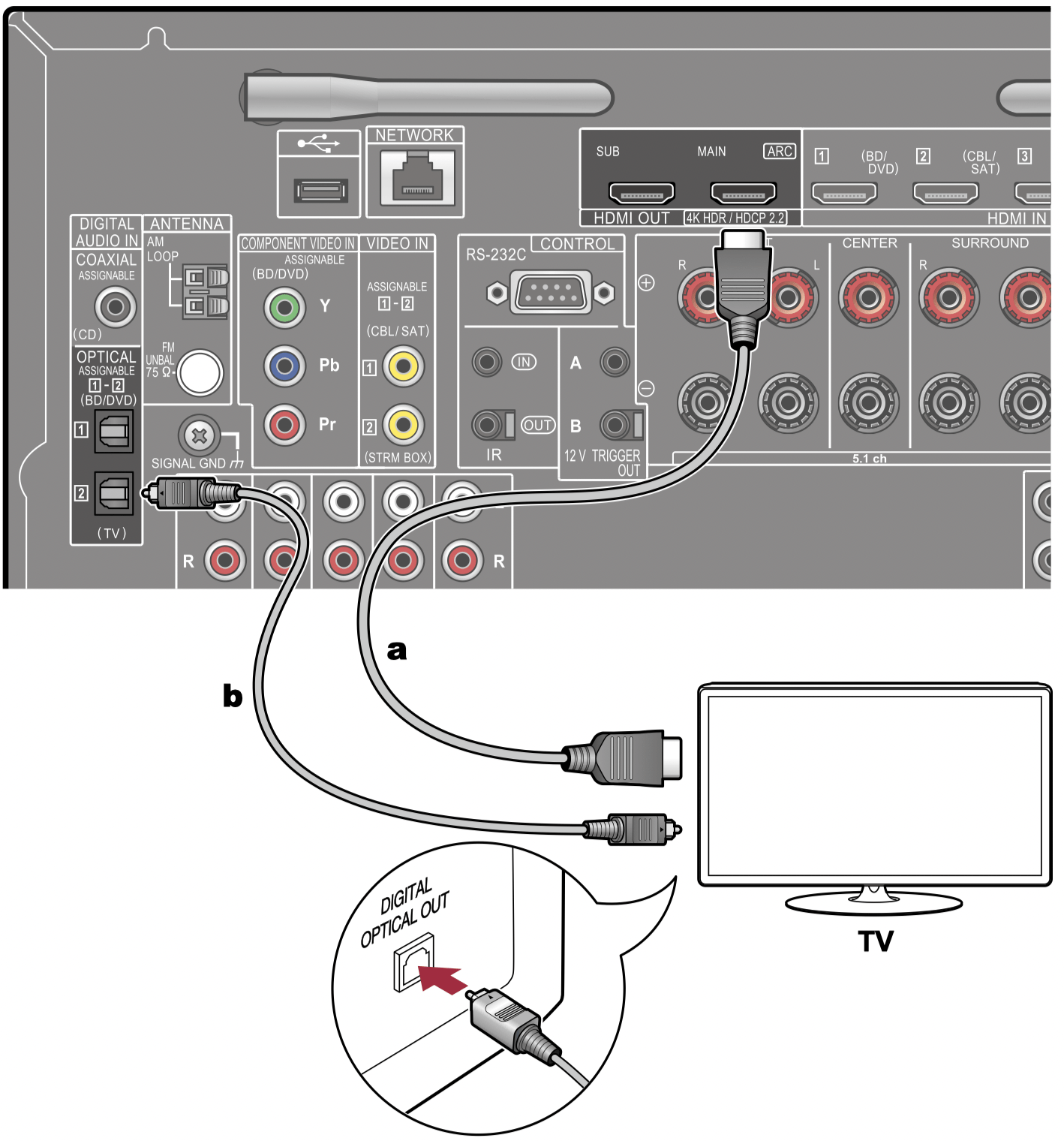
If the TV does not support the ARC (Audio Return Channel) function (*), connect an HDMI cable and digital optical cable. If the TV does not have a DIGITAL OPTICAL OUT jack, you can use an analog audio cable to connect with the AUDIO IN jack.
- If you use a cable set-top box, etc. connected to the input jack of this unit to watch TV (without using a TV’s built-in tuner), connection with a digital optical cable or analog audio cable is not required.
- Another TV or projector can be connected to the HDMI OUT SUB jack. To switch between MAIN and SUB, press the
 button ( p130) on the remote controller, and select "Other" - "HDMI Out". Note that this jack is not ARC compatible.
button ( p130) on the remote controller, and select "Other" - "HDMI Out". Note that this jack is not ARC compatible.
(*) ARC function: This function transmits the audio signals of the TV via an HDMI cable, and plays the audio of the TV on this unit. Connection to an ARC compatible TV is complete with one HDMI cable. To check if the TV supports the ARC function, refer to the instruction manual of the TV, etc.
Connecting an AV Component without HDMI Jack Mounted
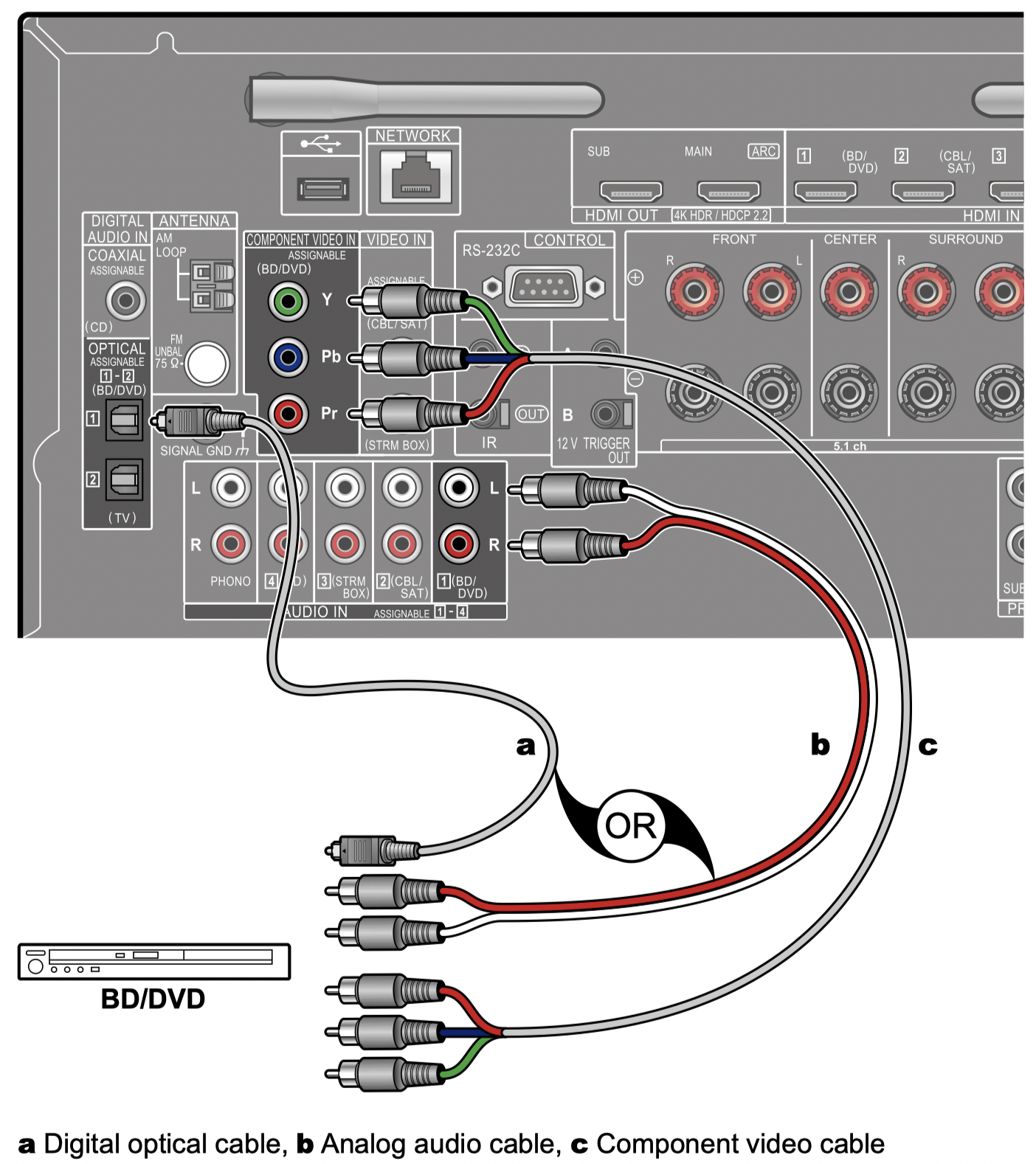
This is a connection example of an AV component unequipped with an HDMI jack. Select cables that match the jacks of the AV component for connection. For example, when video input is connected to the BD/DVD jack, connect the audio input to BD/DVD jack, too. Thus, video input jacks and audio input jacks should have the same name for connection. Note that video signals input to the VIDEO IN jack or the COMPONENT VIDEO IN jack are converted to HDMI video signals, and then output from the HDMI OUT jack.
- To enjoy digital surround playback in formats such as Dolby Digital, you need to make a connection for audio signals with a digital coaxial cable or a digital optical cable.
- According to the illustration, changing the input assignment ( p102) enables connection to jacks other than the BD/DVD jack.
Setup
- The COMPONENT VIDEO IN jacks are compatible only with 480i or 576i resolution. When connecting to the COMPONENT VIDEO IN jacks, set the output resolution of the player to 480i or 576i. If there is no option such as 480i, select interlace. If your player does not support 480i or 576i output, use the VIDEO IN jack.
- To enjoy digital surround sound including Dolby Digital, set the audio output of the connected Blu-ray Disc player etc. to the Bitstream output.
Connecting an Audio Component
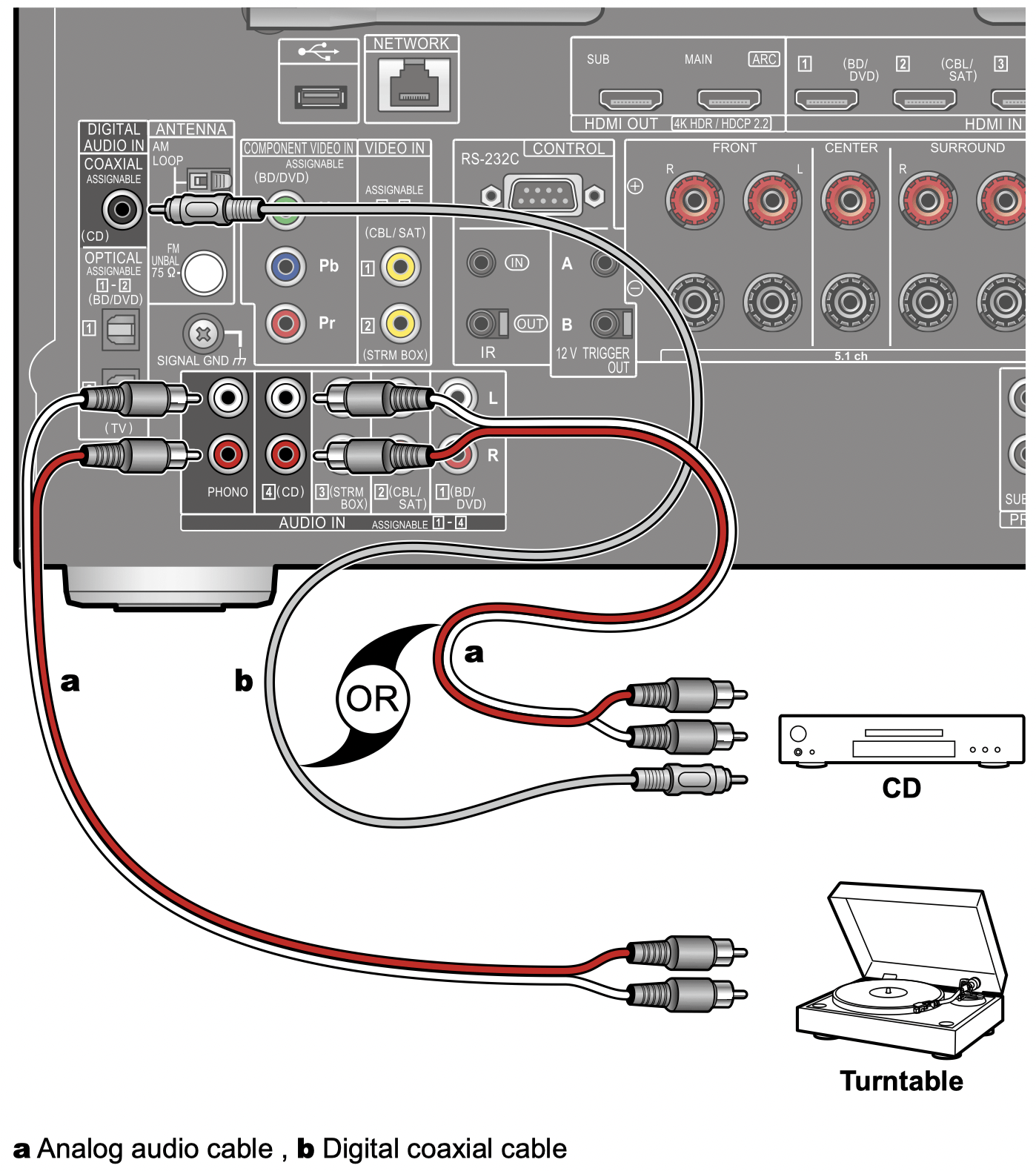
This is a connection example of an audio component. Connect a CD player using a digital coaxial cable or analog audio cable. You can also connect a turntable that has an MM-type cartridge to the PHONO jack.
- If the turntable has a built-in phono equalizer, connect it to any of the AUDIO IN jacks other than the PHONO jack. Further, if the turntable uses an MC type cartridge, install a phono equalizer compatible with the MC type cartridge between the unit and the turntable, and then connect it to any of the AUDIO IN jacks other than the PHONO jack.

If the turntable has a ground wire, connect it to the GND terminal of this unit.
Connecting a Video Camera, etc.
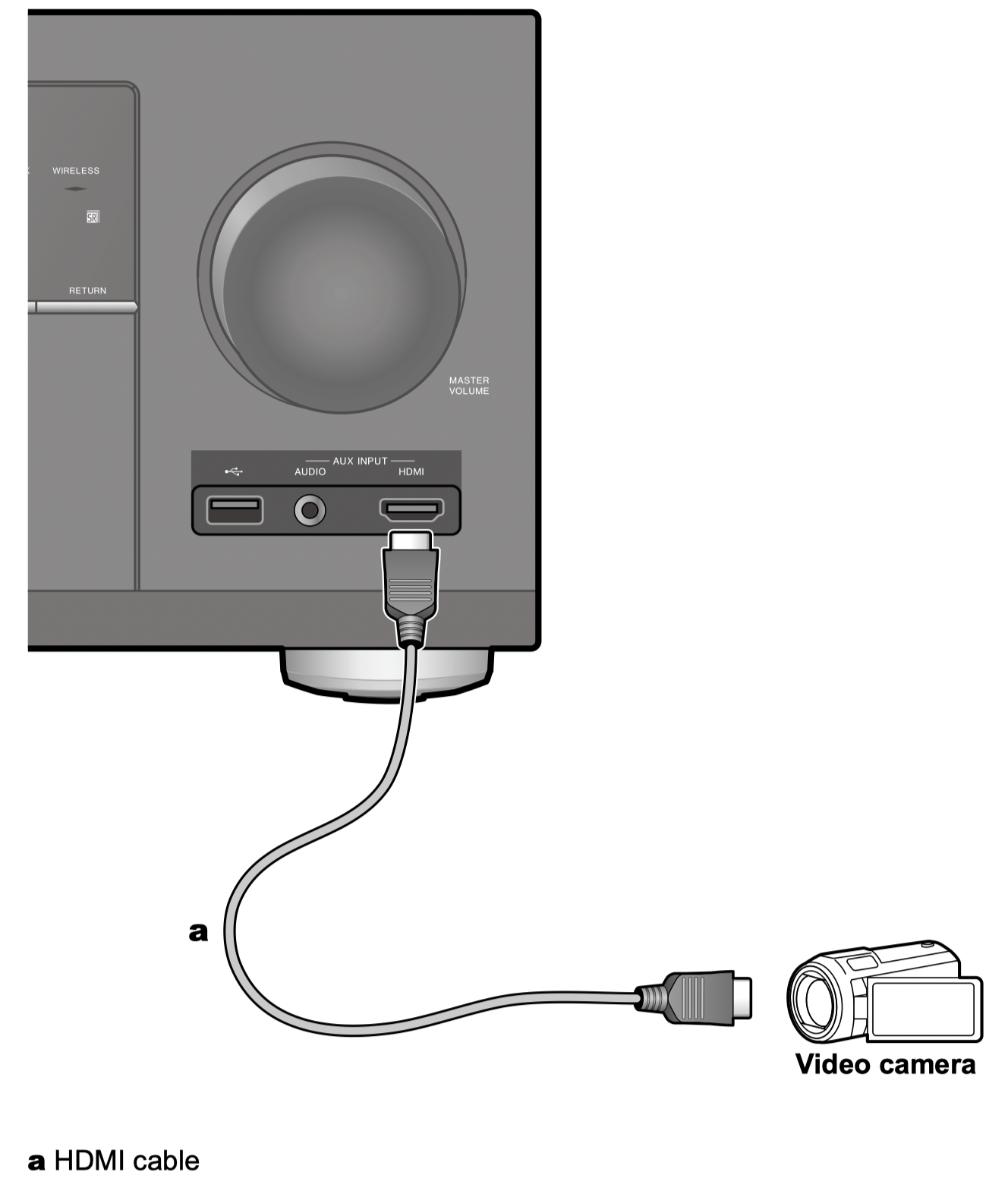
Connect a video camera, etc. to the AUX INPUT AUDIO/HDMI jack on the front panel using an HDMI cable or stereo mini plug cable (ø1/8″/3.5 mm).
Connecting Antennas

Connect the antenna to this unit, and set up the antenna at the best position for listening while receiving radio signals. Attach the indoor FM antenna to the wall using push pins or adhesive tape.
Network Connection
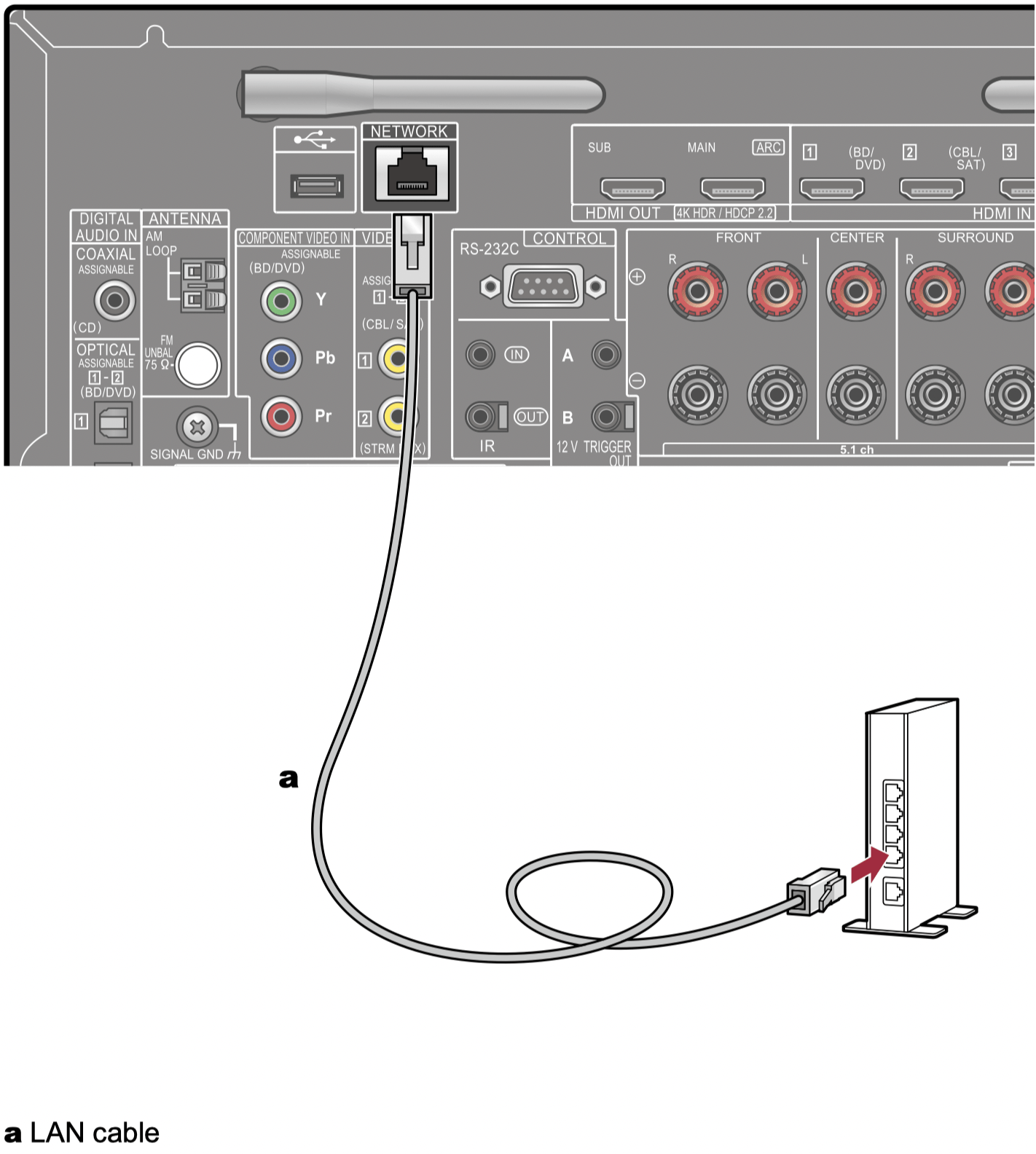
This unit can be connected to the network using a wired LAN or Wi-Fi (wireless LAN). You can enjoy network functions such as Internet radio by network connection. If connection is made by the wired LAN, connect the router and the NETWORK jack with the LAN cable as shown in the illustration. To connect by Wi-Fi, select "Wireless" for "4. Network Connection" in Initial Setup ( p140), select your desired setting method, and then follow the on-screen instructions. For the Wi-Fi connection, stand the wireless antenna for use.
Connecting External Control Devices
IR IN/OUT port
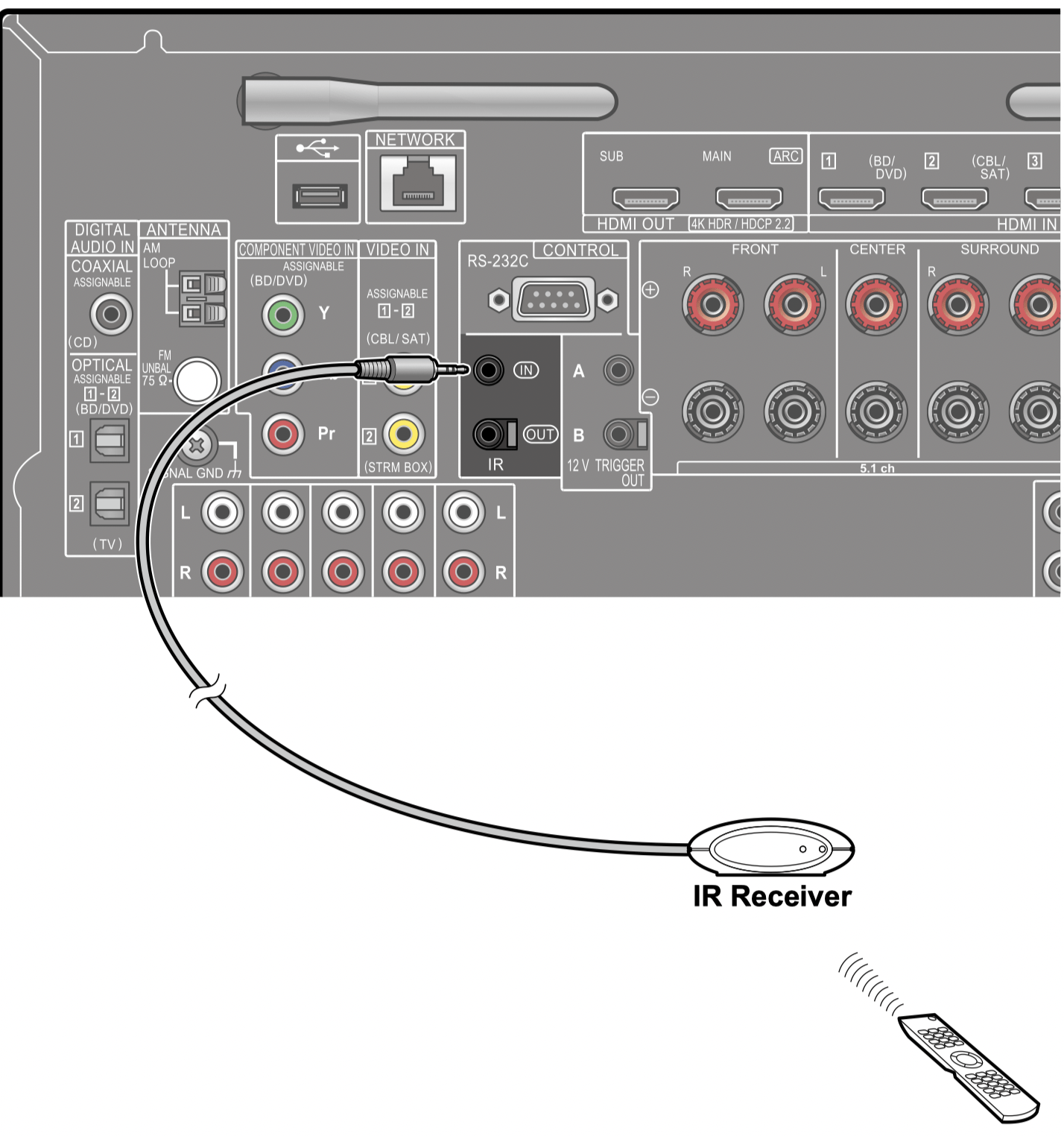
When connecting a remote control receiver unit consisting of an IR Receiver, etc. to this unit, operation using the remote controller is possible even if the remote control signal is difficult to reach (due to installation in the cabinet, etc.). It is also possible to operate this unit from other room such as ZONE 2 with a remote controller, or operate other devices with the remote controller by connecting other devices to this unit. For adopting a remote control receiver unit, contact the specialized stores.
- For the type of cable required for connection, refer to the operation manual, etc. of the remote control receiver unit.
12V TRIGGER OUT jack
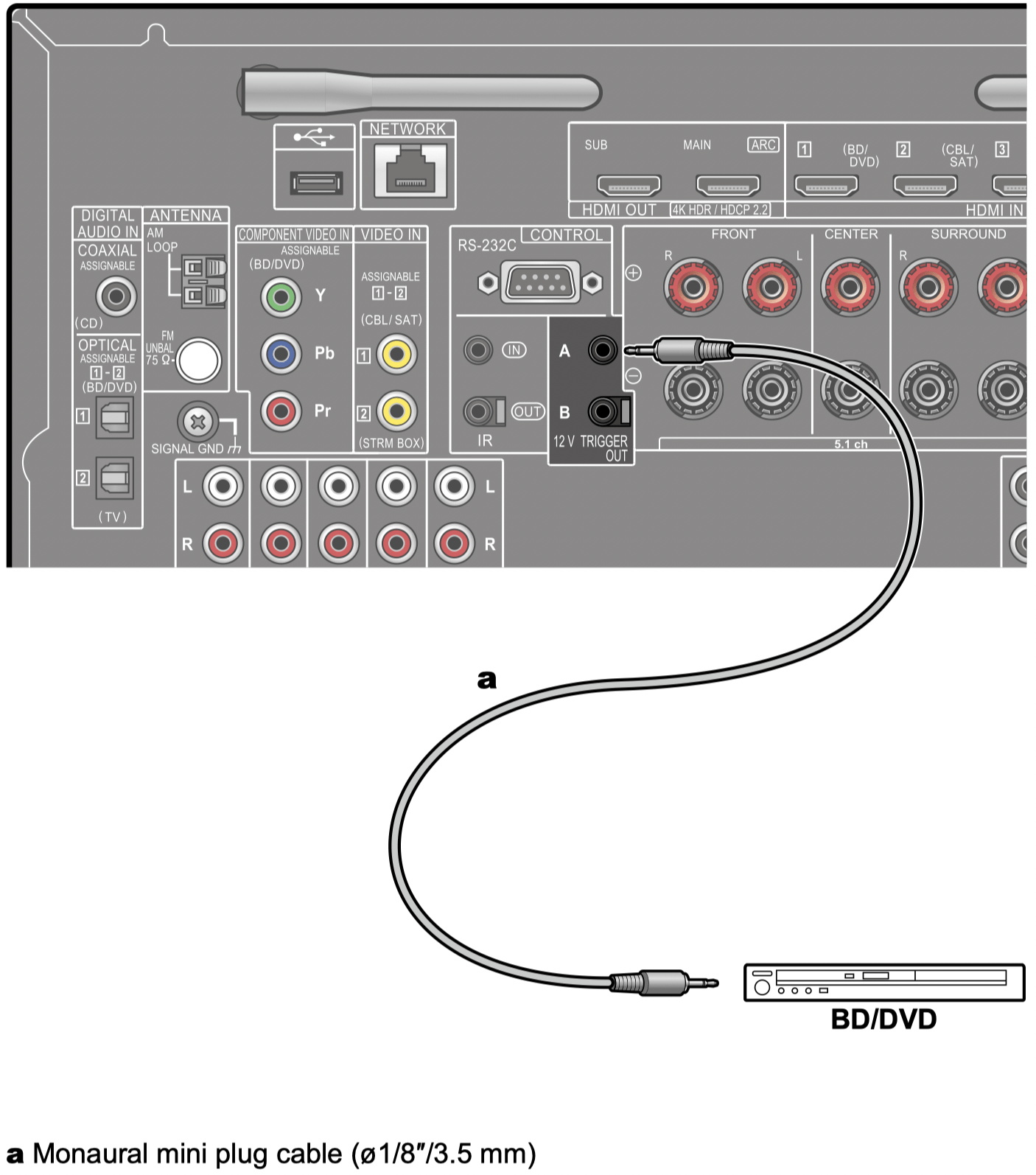
When connecting a device equipped with a TRIGGER IN jack such as a BD/DVD player to this unit, the device can be turned on or set to standby by interlocking the operation on this unit. When the desired input is selected on the unit, power link operation will be activated with a control signal of maximum 12 V/100 mA from the 12V TRIGGER OUT A jack or maximum 12 V/25 mA when using the 12V TRIGGER OUT B jack. You can select the zone to output the control signal by setting each of the inputs.
- For connection, use a monaural mini plug cable (ø1/8″/3.5 mm) without resistance. Do not use a stereo mini plug cable.
Connecting the Power Cord

Connect the power cord after all the connections are completed.
- Be sure to connect the power cord to the AC IN of the unit first, and then connect it to the outlet. Always disconnect the outlet side first when disconnecting the power cord.
Troubleshooting
Before starting the procedure
Problems may be solved by simply turning the power on/off or disconnecting/ connecting the power cord, which is easier than working on the connection, setting and operating procedure. Try the simple measures on both the unit and the connected device. If the problem is that the video or audio is not output or the HDMI linked operation does not work, disconnecting/connecting the HDMI cable may solve it. When reconnecting, be careful not to wind the HDMI cable since if wound the HDMI cable may not fit well. After reconnecting, turn off and on the unit and the connected device.
- The AV receiver contains a microPC for signal processing and control functions. In very rare situations, severe interference, noise from an external source, or static electricity may cause it to lockup. In the unlikely event that this happens, unplug the power cord from the wall outlet, wait at least 5 seconds, and then plug it back in.
- Our company is not responsible for damages (such as CD rental fees) due to unsuccessful recordings caused by the unit’s malfunction. Before you record important data, make sure that the material will be recorded correctly.
When the unit is operating erratically
❏ Try restarting the unit
Restarting this unit may solve the problem. After turning the unit to standby mode, press and hold the STANDBY/ON button of the main unit for at least 5 seconds, and then restart the unit. (The settings on this unit are kept.) If the problem persists after restarting the unit, unplug and plug the power cords of this unit and connected devices.
❏ Resetting the unit (this resets the unit settings to the default)
If the restart of the unit does not solve the problem, reset the unit, and restore all the settings to the factory default at the time of purchase. This may solve the problem. If the unit is reset, your settings are restored to the default values. Be sure to note down your setting contents before performing the following operations.
- While pressing the AUTO/DIRECT button on the main unit, press STANDBY/ON.
- "Clear" is displayed on the display, and the unit returns to the standby state. Do not remove the power cord until "Clear" disappears from the display. To reset the remote controller, while pressing and holding MODE, press the
 button at least 3 seconds until the remote indicator blinks twice.
button at least 3 seconds until the remote indicator blinks twice.
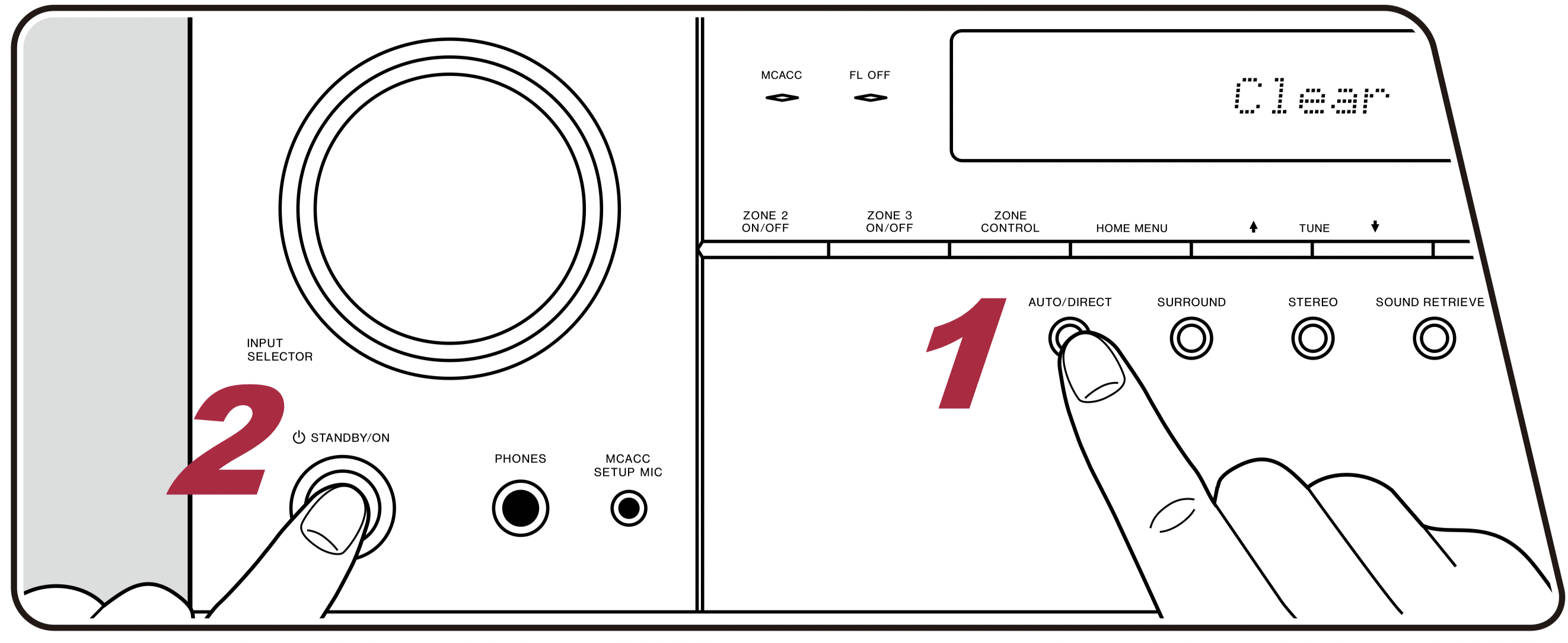
Troubleshooting
Power
❏ Cannot turn on the unit
- Make sure that the power cord is properly plugged into the wall outlet.
- Unplug the power cord from the outlet once, wait 5 seconds or more, then plug it in again.
❏ The unit turns off unexpectedly
- The unit automatically switches to standby when the "System Setup" - "Hardware" - "Power Management" - "Auto Standby" setting in the Home screen functions.
- The protection circuit function may have operated. In such a case, if the power is turned on again, "AMP Dialog Mode" is displayed on the main unit’s display, and the unit enters the diagnosis mode to check the unit for abnormality. As the result, if no problem is found, "AMP Dialog Mode" on the display disappears. Then, you can use the unit normally. If "CHECK SP WIRE" appears on the display, the speaker cables may be short-circuited. Check if the core wire of a speaker cable is not in contact with the core wire of another speaker cable or the rear panel, and turn the power on again If "NG" is displayed, remove the power plug from the outlet immediately, and consult the dealer.
- The protection circuit function may have operated due to an abnormal rise in temperature of the unit. In such a case, the power turns off repeatedly even if the power is turned on each time. Secure sufficient ventilation space around the unit, wait for a while until the temperature of the unit decreases. Then, turn the power on again.
WARNING: If smoke, smell or abnormal noise is produced by the unit, unplug the power cord from the outlet immediately, and contact the dealer or our company's Support.
Audio
- Make sure that the speaker setup microphone is no longer connected.
- Confirm that the connection between the output jack on the connected device and the input jack on this unit is correct.
- Make sure that none of the connecting cables are bent, twisted, or damaged.
- If the
 indicator on the display blinks, press on
indicator on the display blinks, press on  the remote controller to cancel muting.
the remote controller to cancel muting. - While headphones are connected to the PHONES jack, no sound is output from the speakers.
- When "System Setup" - "Source" - "Audio Select" - "Fixed PCM" in the Home Menu is set to "On", no sound is played when signals other than PCM are input. Change the setting to Off.
Check the following if the problem persists after you have confirmed the above.
❏ No sound from the TV
- Change the input selector on this unit to the position of the terminal to which the TV is connected.
- If the TV does not support the ARC function, along with the connection by an HDMI cable, connect the TV with this unit using a digital optical cable, digital coaxial cable, or analog audio cable.
❏ No sound from a connected player
- Change the input selector on this unit to the position of the terminal to which the player is connected.
- Check the digital audio output setting on the connected device. On some game consoles, such as those supporting DVD, the default setting may be off.
- For some DVD-Video discs, you need to select an audio output format from a menu.
❏ A speaker produces no sound
- Make sure that the polarity (+/-) of the speaker cables is correct, and that no bare wires are in contact with the metal part of speaker terminals.
- Make sure that the speaker cables are not shorting out.
- Check "Connect the Speaker Cables" to see if the speaker connections have been made correctly. Settings for the speaker connection environment need to be made in "Speaker Setup" in Initial Setup. Check "Initial Setup with Auto Start-up Wizard".
- Depending on the input signal and listening mode, not much sound may be output from speakers. Select another listening mode to see if sound is output.
- If surround back speakers are installed (for compatible models only), be sure to install surround speakers as well.
- A maximum of 7.1 ch playback is possible when Bi-Amping connection is used (for compatible models only). Be sure to remove the jumper bar on the speakers when using Bi-Amping connection.
❏ The subwoofer produces no sound
If the setting of the front speakers is "Large", the low range elements will be output from the front speakers instead of from the subwoofer during 2 ch audio input of TV or music. To output the sound from the subwoofer, make one of the following settings.
1. Change the front speakers settings to "Small".
The low range elements will be output from the subwoofer rather than the front speakers. We do not recommend changing this if your front speakers have good low range reproduction capabilities.
2. Change "Double Bass" to "On".
The low range elements of the front speakers will be output from both the front speakers and the subwoofer. Due to this, the bass sound may be emphasized too much. In such a case, do not change the setting, or make the setting with the above option 1.
- For the setting details, refer to "System Setup" - "Speaker" - "Crossover".
- If the input signals do not contain subwoofer audio elements (LFE), the subwoofer may produce no sound.
❏ Noise can be heard
- Using cable ties to bundle audio pin cables, power cords, speaker cables, etc. may degrade the audio performance. Do not bundle the cords.
- An audio cable may be picking up interference. Change the position of the cables.
❏ The beginning of audio received by an HDMI IN cannot be heard
- Since it takes longer to identify the format of an HDMI signal than it does for other digital audio signals, audio output may not start immediately.
❏ Sound suddenly reduces
- When using the unit for extended periods with the temperature inside the unit exceeding a certain temperature, the volume may be reduced automatically to protect the circuits.
Listening Modes
- To enjoy digital surround playback in formats such as Dolby Digital, you need to make a connection for audio signals with an HDMI cable, digital coaxial cable or digital optical cable. Also, audio output need to be set to Bitstream output on the connected Blu-ray Disc player, etc.
- Press on the remote controller several times to switch the display of the main unit, and you can check the input format. Check the following if the problem persists after you have confirmed the above.
❏ Cannot select a desired listening mode
- Depending on the connection status of the speaker, some listening modes may not be selected. Refer to "Selectable Listening Modes" in "Listening Mode".
❏ Cannot listen to the sound in Dolby TrueHD, Dolby Atmos or DTS-HD Master Audio format (for compatible models only)
- You need to connect surround back speakers or height speakers to enjoy Dolby Atmos. Also, Dolby Atmos can be enjoyed only when the input signals are in Dolby Atmos formats.
- If the audio in Dolby TrueHD, Dolby Atmos or DTS-HD Master Audio format cannot be output correctly in the source format, set "BD video supplementary sound" (or re-encode, secondary sound, video additional audio, etc.) to "Off" in the setting of a connected Blu-ray Disc player, etc. After changing the setting, switch the listening mode to that for each source, and confirm.
❏ About DTS signals
- With media that switches suddenly from DTS to PCM, PCM playback may not start immediately. In such a case, stop playback on the player side for approx. 3 seconds or more. Then, resume playback. The playback will be performed normally.
- DTS playback may not be performed normally on some CD and LD players even if the player and this unit are digitally connected. If some processing (e.g., output level adjustment, sampling frequency conversion, or frequency characteristic conversion) has been executed for the DTS signal being output, this unit cannot recognize it as a genuine DTS signal, and noise may occur.
- While playing a DTS-compatible disc, if a pause or skip operation is performed on your player, noise may occur for a short period. This is not a malfunction.
Video
- Confirm that the connection between the output jack on the connected device and the input jack on this unit is correct.
- Make sure that none of the connecting cables are bent, twisted, or damaged.
- When the TV image is blurry or unclear, the power cord or connection cables of the unit may have interfered. In such a case, keep distance between TV antenna cable and cables of the unit.
- Check the switching of the input screen on the monitor side such as a TV. Check the following if the problem persists after you have confirmed the above.
❏ No image appears.
- Change the input selector on this unit to the position of the terminal to which the player is connected.
❏ No image from a device connected to HDMI IN jack
- To display video from the connected player on the TV while the unit is in standby, you need to enable "System Setup" - "Hardware" - "HDMI" "HDMI Standby Through" in the Home screen. For details of the HDMI Standby Through function, refer to "System Setup" - "Hardware" "■ HDMI".
- To output video to a TV connected to the HDMI OUT SUB jack (for compatible models only), press on
 the remote controller to display "AV Adjust", and select "Other" - "HDMI Out". Then, select the HDMI OUT jack for output.
the remote controller to display "AV Adjust", and select "Other" - "HDMI Out". Then, select the HDMI OUT jack for output. - Check if "Resolution Error" is displayed on the main unit display when video input via HDMI IN jack is not displayed. In this case, the TV does not support the resolution of the video input from the player. Change the setting on the player.
- Normal operation with an HDMI-DVI adapter is not guaranteed. In addition, video signals output from a PC are not guaranteed.
❏ Images flicker
- The output resolution of the player may not be compatible with the resolution of the TV. If the player is connected to this unit with an HDMI cable, change the output resolution on the player. Also this may be solved by changing the screen mode on the TV.
❏ Video and audio are out of synch
- Depending on the settings on your TV and connection environment, the video may be behind the audio. Video may be delayed relative to audio depending on the settings and connections with your television. To adjust, press on
 the remote controller, and adjust in "Other" - "Sound Delay" in the "AV Adjust".
the remote controller, and adjust in "Other" - "Sound Delay" in the "AV Adjust".
Linked operation
❏ HDMI linked operation does not work with CEC-compliant devices, such as a TV
- In the Home screen of the unit, set "System Setup" - "Hardware" - "HDMI" - "HDMI CEC" to "On".
- It is also necessary to set HDMI linking on the CEC-compliant device. Check the instruction manual.
- When connecting a Sharp brand player or recorder to the HDMI IN jacks, set "System Setup" - "Hardware" - "HDMI" - "HDMI Standby Through" to "Auto".
Tuner
❏ Poor reception or much noise
- Recheck the antenna connection.
- Move the antenna away from the speaker cord or power cord.
- Move the unit away from your TV or PC.
- Passing cars or airplanes in the vicinity can cause interference.
- If radio waves are blocked by concrete walls, etc., radio reception may be poor.
- Change the reception mode to mono.
- Operating the remote controller during AM reception may cause noise.
- FM reception may be clearer if you use the antenna jack on the wall used for the TV.
BLUETOOTH function
- Unplug and plug the power cord of the unit, or turn off and on the BLUETOOTH-enabled device. Restart of the BLUETOOTH-enabled device may be effective.
- BLUETOOTH-enabled devices must support the A2DP profile.
- Because a radio wave interference will occur, this unit may not be used near devices such as a microwave oven or cordless phone which use the radio wave in the 2.4 GHz range.
- A metallic object near the unit can affect on the radio wave, and BLUETOOTH connection may not be possible. Check the following if the problem persists after you have confirmed the above.
❏ Cannot connect with this unit
- Check if the BLUETOOTH function of the BLUETOOTH-enabled device is enabled.
❏ Music playback is unavailable on the unit even after successful BLUETOOTH connection
- When the audio volume of your BLUETOOTH-enabled device is set low, the audio may not be played back. Turn up the volume of the BLUETOOTH-enabled device.
- Depending on the BLUETOOTH-enabled device, the Send/Receive selector switch may be equipped. Select Send mode.
- Depending on the characteristics or specifications of the BLUETOOTH-enabled device, music may not be played back on this unit.
❏ Sound is interrupted
- There may a problem with the BLUETOOTH-enabled device. Check the information on a web page.
❏ The audio quality is poor after connection with a BLUETOOTH-enabled device
- The BLUETOOTH reception is poor. Move the BLUETOOTH-enabled device closer to the unit, or remove any obstacle between the BLUETOOTH-enabled device and this unit.
Network function
- If you cannot select a network service, start up the network function to select it. It may take approx. one minute to start it up.
- When the NET indicator is blinking, this unit is not properly connected to the home network.
- Unplug and plug the power cords of this unit and the router, or restart the router.
- If the desired router is not displayed in the access point list, it may be set to hide SSID, or the ANY connection may be off. Change the setting and try again.
Check the following if the problem persists after you have confirmed the above.
❏ Cannot access the Internet radio
- In the case the service provider has terminated the service, the network service or contents may not be used on this unit.
- Check if your modem and router are properly connected, and they are both turned on.
- Check if the LAN side port on the router is properly connected to this unit.
- Check if connecting to Internet from other devices is possible. If it is not possible, turn off all devices connected to the network, wait for a while, and then turn on the devices again.
- If only the specific radio station is unavailable for listening, check if he registered URL is correct, and if the format distributed from the radio station is supported by this unit.
- Depending on ISP, setting the proxy server is required.
- Check if the router and modem you are using are supported by your ISP.
❏ Cannot access the network server
- This unit needs to be connected to the same router as the network server.
- This unit supports the Windows Media ® Player 11 or 12 network servers, or NASes that support the home network function.
- Windows Media ® Player may require some settings. Refer to "Playing back files on a PC and NAS (Music Server)".
- When using a PC, only the music files registered in the library of Windows Media ® Player can be played.
❏ Sound is interrupted when playing music files on the network server
- Check if the network server meets the requirements for operation.
- When the PC is serving as the network server, quit application software other than the server software (Windows Media ® Player 12, etc.).
- If the PC is downloading or copying large files, the playback sound may be interrupted.
❏ The initial setup of Chromecast built-in cannot be performed on Pioneer Remote App
- If you have agreed to the privacy policy that requires agreement to use the Chromecast built-in function during the Initial Setup of this unit, you do not have to agree to the privacy policy on Pioneer Remote App.
USB storage device
❏ USB storage device is not displayed
- Check if the USB storage device or USB cable is securely inserted to the USB port of the unit.
- Disconnect the USB storage device once from the unit, and then reconnect it.
- Performance of the hard disk that receive power from the USB port of the unit is not guaranteed.
- Depending on the type of content, the playback may not be performed normally. Check the types of supported file formats.
- Operations of USB storage devices equipped with security functions are not guaranteed.
Wireless LAN Network
- Unplug and plug the power cords of this unit and the wireless LAN router, check the power-on status of the wireless LAN router, or restart the wireless LAN router.
Check the following if the problem persists after you have confirmed the above.
❏ Cannot access wireless LAN network
- The wireless LAN router setting may be switched to Manual. Restore the setting to Auto.
- Try the manual set-up. The connection may succeed.
- When the wireless LAN router is in stealth mode (mode to hide SSID) or when the ANY connection is off, the SSID is not displayed. Change the setting and try again.
- Check if the SSID and encryption settings (WEP, etc.) are correct. Match the network settings with the settings of this unit.
- Connection to an SSID that includes multi-byte characters is not supported. Set the SSID of the wireless LAN router using single-byte alphanumeric characters only, and try again.
❏ Connected to an SSID different from the selected SSID
- Some wireless LAN routers allow you to set multiple SSIDs for one unit. If connecting to such a router using the automatic setting button, you may end up connecting to an SSID different from the SSID you want to connect to. If this occurs, use the connection method requiring you to enter a password
❏ Playback sound is interrupted, or communication is not possible
- You may not receive radio waves due to poor radio wave conditions. Shorten the distance from the wireless LAN router, or remove obstacles to improve visibility, and connect again. Install the unit away from microwave ovens or other access points. It is recommended to install the wireless LAN router and the unit in the same room.
- If there is a metallic object near the unit, wireless LAN connection may not be possible because the metal affects the radio wave.
- When other wireless LAN devices are used near the unit, other symptoms may occur, such as interrupted playback and impossible communication. You can avoid those problems by changing the channel of your wireless LAN router. For instructions on changing channels, refer to the instruction manual supplied with your wireless LAN router.
- There may not be enough bandwidth available in wireless LAN. Use a wired LAN for connection.
Multi-zone function (for compatible models only)
❏ Cannot ZONE-output the audio of externally connected AV components
- To output audio from an externally connected AV component to ZONE 2, use either a digital coaxial cable, digital optical cable or analog audio cable for connection. Also, the audio from externally connected AV components can be output to ZONE 2 only when the audio is analog or 2ch PCM signal. When the AV component is connected to this unit with a digital coaxial cable or digital optical cable, change the audio output of the AV component to the PCM output.
- To output audio from an externally connected AV component to ZONE 3, use an analog audio cable for connection. Also, audio from externally connected AV components can be output to ZONE 3 only when it is an analog audio signal.
❏ Others
- If the audio signal is from the NET or USB input selector, zone output is not possible for DSD and Dolby TrueHD audio signals.
Remote Controller
- Make sure that the batteries are inserted with the correct polarity.
- Insert new batteries. Do not mix different types of batteries, or old and new batteries.
- Make sure that the sensor of the main unit is not subjected to direct sunlight or inverter-type fluorescent lights. Relocate it if necessary.
- If the main unit is installed in a rack or cabinet with colored-glass doors, or if the doors are closed, the remote controller may not work normally.
- After operating the Multi-zone function (for compatible models only), the remote controller mode may be switched to the mode for operating the ZONE output audio. Check "Multi-zone", and switch the remote controller mode to the mode for controlling the main room.
Display
❏ The display does not light up
- When the Dimmer function is working, the display may go dim or turn off (for compatible models only). Press the DIMMER button, and change the brightness level of the display.
Others
❏ Strange noise can be heard from the unit
- If you have connected another device to the same outlet as this unit, strange noise may occur under the influence of the device. If the symptom is remedied by removing the power plug of the other device from the outlet, use different outlets for this unit and the device.
❏ The message "Noise Error" appears during Full Auto MCACC
- This can be caused by a malfunction in your speaker unit. Check the speaker output, etc.
❏ The measurement results of Full Auto MCACC show different distances to the speakers from the actual ones
- Depending on the speakers you are using, some errors may occur in the measurement results. If this is the case, make the settings in "System Setup" - "Speaker" - "Distance".
❏ The measurement results of Full Auto MCACC show that the volume level of the subwoofer has been corrected to the lower limit
- The volume level correction of the subwoofer may not have been completed. Lower the volume of the subwoofer before Full Auto MCACC measurement.
❏ DRC function does not work
- Make sure the source material is Dolby Digital, Dolby Digital Plus, Dolby TrueHD, or DTS.
See other models: SX-10AE DJM-450 SP-C22 S-DJ80X PL-30-K
